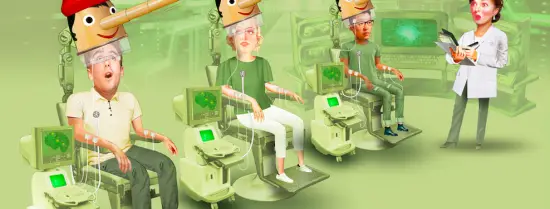
Although Dutch people are regarded as quite direct and honest when compared to people from many other countries, a little white lie here and there smoothens even the Dutch interactions. The majority of people tells lies every day. Most of those lies are relatively harmless and can even serve as a social glue. Diary research on lie frequency consistently shows that some people lie more than others and that some lies are more harmful than others. To identify those harmful lies, which often concern lies told in a police-, intelligence-, or courtroom context, researchers have developed new methods to detect deceit.
The Polygraph
Both lay people and professionals tend to think solely of the polygraph when asked about lie detection, even though many more detection techniques are now available. The polygraph is a machine that measures physiological stress responses caused by lying such as pulse, blood pressure, skin conductance (sweatiness of fingers), and respiration. Over the years, the polygraph has been used for reallife lie detection, preferably by dramatically revealing deceit in romantic relationships. These practices have made the polygraph famous amongst a broad audience, but it also led to much critique.
For example, there is a large gap between the performance claims of commercial companies and of the media on the one hand, who often claim that the accuracy rates are 95-99.9% and of the scientific community on the other hand, who find accuracy rates of 74-82% for guilty suspects and 61-83% for innocent suspects in lab experiments when using the Control Question Technique. Those lab experiments also show that the percentage of innocent people being judged as liars is 10-29%, which is very high. Other polygraph issues are the subjectivity of judging the data output, the ability to fool the machine by applying countermeasures, and the problem that some people – for example people who score high on psychopathy – do not display signs of nervousness when lying.
Human judgement
In a series of interviews with Dutch practitioners I found that they tend to prefer relying on their own judgements rather than using technology to detect deceit. Relying on human judgements to detect deception is problematic, because people are terrible at lie detection. There is no human equivalent of Pinocchio’s nose or some clear and stable indicator that someone is lying. Clues to deceit are often subtle and their effect sizes are small, making them difficult to spot. Research systematically shows that people do not perform much better than chance levels when attempting to detect deceit. Years of experience or training sessions tend to improve confidence levels much more than they improve detection accuracy, leading to strong but wrong opinions.
'Relying on human judgements to detect deception is problematic, because people are terrible at lie detection'
Lie detection based on body movement
Together with my colleague Ronald Poppe from Utrecht University, I have developed several technological deception detection methods, with the aim to overcome the issues related to the polygraph and human judgements. One of the main issues of the polygraph is that it solely measures physiological stress responses, whilst lying can also cause increased cognitive load and behavioural control, which can subsequently affect a liar’s behaviour. We developed an automated lie detection method based on people’s body movement. We measured movement using full-body motion capture suits, recording the liar’s movement 120 times per second. Analyses of 90 interviews revealed that most people move more when lying compared to when telling the truth and this finding was consistent across all body parts. In this study, our algorithm (82% accuracy) could detect deceit almost 30% better than humans (53% accuracy).
Framing of lies
Lying also affects our verbal behaviour; people phrase and frame their lies differently than their truths. Using linguistic analysis software, we developed the first personalised deception model based on the factchecked tweets of US President Donald Trump. Trump uses much more cognitive processing-, tentative-, and comparison words when lying, and more emotional words when telling the truth. With this model, we could correctly classify (out-of-sample) almost three quarters of his factually incorrect tweets, solely based on the types of words he uses when tweeting.
'Trump uses much more cognitive processing-, tentative-, and comparison words when lying, and more emotional words when telling the truth'
Improving lie detection
We are currently developing and testing a multimodal deception detection technique, which measures changes in language use, body movement, and facial expressions when lying. Our first real-world multimodal deception detection test was covered in the BBC Horizon documentary 'A week without lying: the honesty experiment.' And recently we gathered a large dataset with lying children, adolescents, adults, and elderly, who took part in our deception experiment recorded in Nemo Science Museum Amsterdam. With this data, we aim to further refine our automated multimodal deception detection method and continue to improve detection accuracies and robustness.
